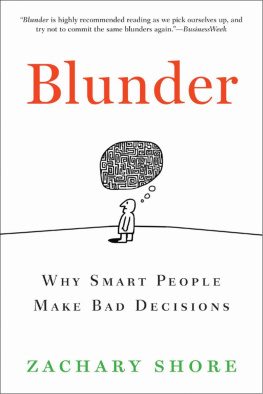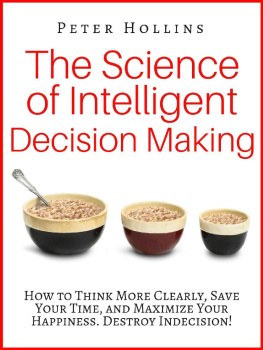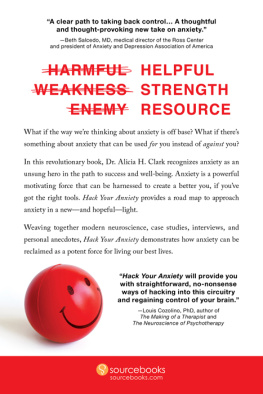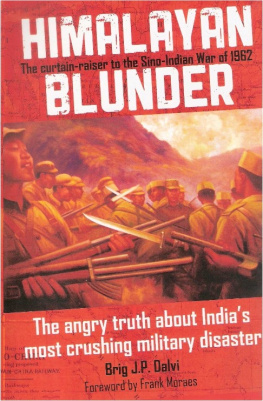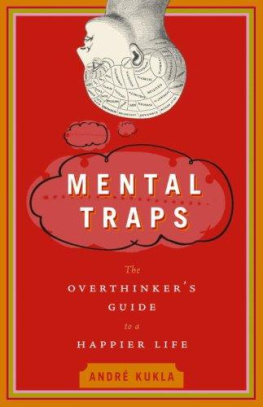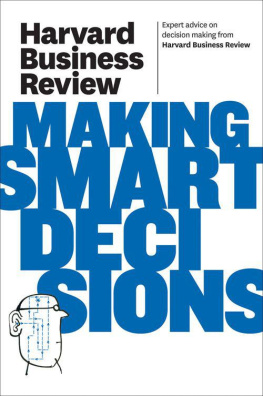Zachary Shore - Blunder: Why Smart People Make Bad Decisions
Here you can read online Zachary Shore - Blunder: Why Smart People Make Bad Decisions full text of the book (entire story) in english for free. Download pdf and epub, get meaning, cover and reviews about this ebook. year: 2010, publisher: Bloomsbury Publishing, genre: Politics. Description of the work, (preface) as well as reviews are available. Best literature library LitArk.com created for fans of good reading and offers a wide selection of genres:
Romance novel
Science fiction
Adventure
Detective
Science
History
Home and family
Prose
Art
Politics
Computer
Non-fiction
Religion
Business
Children
Humor
Choose a favorite category and find really read worthwhile books. Enjoy immersion in the world of imagination, feel the emotions of the characters or learn something new for yourself, make an fascinating discovery.
- Book:Blunder: Why Smart People Make Bad Decisions
- Author:
- Publisher:Bloomsbury Publishing
- Genre:
- Year:2010
- Rating:4 / 5
- Favourites:Add to favourites
- Your mark:
- 80
- 1
- 2
- 3
- 4
- 5
Blunder: Why Smart People Make Bad Decisions: summary, description and annotation
We offer to read an annotation, description, summary or preface (depends on what the author of the book "Blunder: Why Smart People Make Bad Decisions" wrote himself). If you haven't found the necessary information about the book — write in the comments, we will try to find it.
Zachary Shore: author's other books
Who wrote Blunder: Why Smart People Make Bad Decisions? Find out the surname, the name of the author of the book and a list of all author's works by series.
Blunder: Why Smart People Make Bad Decisions — read online for free the complete book (whole text) full work
Below is the text of the book, divided by pages. System saving the place of the last page read, allows you to conveniently read the book "Blunder: Why Smart People Make Bad Decisions" online for free, without having to search again every time where you left off. Put a bookmark, and you can go to the page where you finished reading at any time.
Font size:
Interval:
Bookmark:
BLUNDER
BY THE SAME AUTHOR
Breeding Bin Ladens: America, Islam,
and the Future of Europe
What Hitler Knew: The Battle for Information
in Nazi Foreign Policy
BLUNDER
WHY SMART PEOPLE
MAKE BAD DECISIONS
Zachary Shore

Copyright 2008 by Zachary Shore
All rights reserved. No part of this book may be used or reproduced in any manner whatsoever without written permission from the publisher except in the case of brief quotations embodied in critical articles or reviews. For information address Bloomsbury USA, 175 Fifth Avenue, New York, NY 10010.
Published by Bloomsbury USA, New York
All papers used by Bloomsbury USA are natural, recyclable products made from wood grown in well-managed forests. The manufacturing processes conform to the environmental regulations of the country of origin.
LIBRARY OF CONGRESS CATALOGING-IN-PUBLICATION DATA
Shore, Zachary.
Blunder : why smart people make bad decisions / by Zachary Shore.1st U.S. ed.
p. cm.
Includes bibliographical references.
eISBN: 978-1-60819-254-0
1. Decision making. 2. Problem solving. 3. Intellect. 4. Stupidity. 5. Errors. 6. Cognitive therapy. I. Title.
BF448.S45 2008
153.8'3dc22
2008015233
First published by Bloomsbury USA in 2008
This paperback edition published in 2009
13579108642
Typeset by Westchester Book Group
Printed in the United States of America
by Quebecor World Fairfield
To the officers who study at
the Naval Postgraduate School
and in memory of
Gerald Feldman
an exceptional historian, mentor, and mensch
April 24, 1937, to October 31, 2007
CONTENTS
B Y AGE THIRTY-FIVE, Thomas Alva Edison stood at the peak of his career. Presidents asked to meet him. Financiers hoped to fund him. Journalists vied to quote him, desperate to report his latest breakthroughs. Tourists crowded daily in his lab, just to watch him capture human voices on a disc and hear them back again. In a time before television, his image was so recognizable that a letter sent from North Carolina bearing only a sketch of his face easily reached him in New Jersey. The mere invoking of his name suggested genius, hard work, and the American can-do spirit. Then, in 1882, he illuminated part of New York City with his first central power station. So many other cities requested stations of their own that his company simply lost count. Edison had become a national icon, and the future looked full of fortune. There was a problem, however, one so obvious that Edison should easily have grasped it. The world was already outgrowing the very electric system he had helped devise. Edisons lightbulbs used direct current, but only alternating current could power both tiny lightbulbs and gigantic machines over vast distances. When one of Edisons star employees, a young man named Nikola Tesla, explained how they could harness alternating current and transform the way people live, Edison would have none of it. Edison had built his fame on direct current, and he could not imagine that anything more was needed. It was an exceptionally bad decision. By rejecting a new and far superior technology, Edison set the stage for Tesla to eclipse him.
If mad scientists had a prototype, Nikola Tesla would be it. Nearly everything he did had to be divisible by three. He would swim twenty-seven laps each morning. He would only eat breakfast with eighteen napkins set at his place. He would count the number of steps from his lodging to his office, and if that number was not divisible by three, he would circle around the block to make the calculation fit. Certain furry things repulsed him. The thought of touching someones hair made him queasy. The presence of a peach produced a fever. In his later years, he developed an excessive, almost romantic attachment to pigeons. Despite these traits, or perhaps because of them, his close friends, like Mark Twain and Robert Underwood Johnson, found him utterly endearing. For their friendship, Tesla now and then delighted them with his laboratory magic. The tall and boyishly exuberant Serb mesmerized his visitors by sending bolts of spectral light dancing across the room. He commanded electric fireballs to engulf his body and always emerged unscathed. Occasionally he literally shocked the onlookers by directing waves of colored currents through his guests. Mark Twain and friends were privy to a futuristic light show at a time when electricity was barely understood. But to bring his magic to the world, Tesla would have to confront the wrath of the man synonymous with electric light.
Tesla had an endless stream of ideas that led him toward inventions far before his time. He saw that the future was wireless and constructed the first rudimentary radio, even before Marconi. Tesla built the first remote control device and demonstrated to amazed New Yorkers how he could use it to command a model submarine from a distance. He created the field of telegeodynamics, once even simulating an earthquake in New York City that shattered windows across town. His work inspired the cyclotron, a device used for smashing atoms that is central to subparticle physics. He made substantial, some believe decisive, contributions to the development of robotics, ballistics, and theoretical physics. When he died in 1943 at age eighty-six, the U.S. government confiscated part of his plans and equipment, believing that the military applications of his ideas could be immense. Thomas Edison clearly underestimated th e ta lent he had in his employ.
After being rebuffed by Edison over AC power, Tesla was snapped up by an aggressive, farsighted entrepreneur. George Westinghouse purchased the rights to Teslas patents and hired the young inventor as a consultant. Westinghouse then began promoting the use of AC generators, placing Teslas system in direct competition with Edisons. Edison fought back with a protracted campaign to discredit AC by highlighting its many dangers.
One of his most egregious ploys involved a new form of execution. Edison convinced the New York State correctional authorities that death by electrocution in a specially wired apparatus would be fast and efficient. This so-called electric chair would of course require alternating current. Before Edison could release his device, it had to be tested. Neighbors began to notice that their pets were disappearing. Dogs, birds, cows, and horses were all made subjects in a gruesome experiment. When the day came at last for the first prisoner to be electrocuted, the procedure went horribly wrong. William Kemmler was essentially roasted in a spectacle too grisly to describe. Westinghouse, Tesla, and the many proponents of ACs tremendous benefits were outraged at this perverted use of their technology and vowed to strike back. The battle of the currents was on.
Despite Edisons best efforts to discredit it, AC was on its way to becoming the standard current for industrial production. Teslas designs were simply too practical to be resisted, and Westinghouse grasped that the tide would eventually turn in their favor. The public just needed a clearer demonstration of the good that AC could do. That chance came with the arrival of the 1893 Chicago Worlds Fair. Edison and other electric companies hoped to profit financially by lighting that event. Westinghouse recognized it as a public relations bonanza. Thousands of spectators oohed and aahed as AC power illuminated the night sky in a light show that truly none had ever seen before. Electricity was still unknown to most people who used only gaslight and tallow candles. Thousands from Europe joined the crowds of Americans at that event. They came to see not just the dazzling colored lights but the star who made them shine. Dressed in coat and tails, the enigmatic Tesla put on a show of wizardry, to everyones delight. Few in the crowd could grasp the scientific explanations, but all could marvel at the magical whirl of sparkling currents. Not long after their brilliant display at the Worlds Fair, Westinghouse telephoned Tesla in his laboratory with news. He had just landed the Niagara Falls contract. The power of those falls would spin gigantic turbines generating alternating current to run industrial machines. This was the companys most significant contract yet. Soon ACs tremendous potential would be undisputed. Teslas dreams were coming true. So, too, were Edisons worst fears.
Next pageFont size:
Interval:
Bookmark:
Similar books «Blunder: Why Smart People Make Bad Decisions»
Look at similar books to Blunder: Why Smart People Make Bad Decisions. We have selected literature similar in name and meaning in the hope of providing readers with more options to find new, interesting, not yet read works.
Discussion, reviews of the book Blunder: Why Smart People Make Bad Decisions and just readers' own opinions. Leave your comments, write what you think about the work, its meaning or the main characters. Specify what exactly you liked and what you didn't like, and why you think so.

